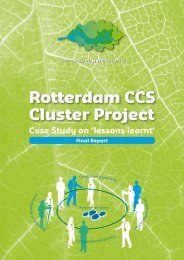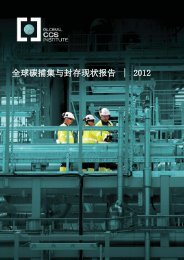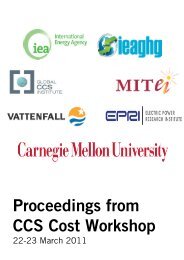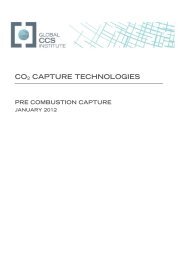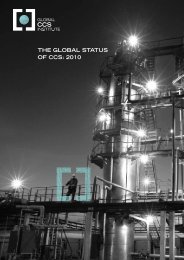Perceptions of CO2 Report - Global CCS Institute
Perceptions of CO2 Report - Global CCS Institute
Perceptions of CO2 Report - Global CCS Institute
- No tags were found...
You also want an ePaper? Increase the reach of your titles
YUMPU automatically turns print PDFs into web optimized ePapers that Google loves.
7 Results7.1 Qualitative resultsThe following sections describe interview and focus group results regarding respondents’knowledge and perceptions <strong>of</strong> CO 2 and <strong>CCS</strong>, as well as reporting on the effect <strong>of</strong> providinginformation. Sample quotations from interviews and focus groups are presented in Appendix E.7.1.1 KNOWLEDGE AND PERCEPTIONS OF CO 2 AND CLIMATE CHANGEAll respondents from the interviews and focus groups (except one member <strong>of</strong> an Australian focusgroup) were aware <strong>of</strong> CO 2 , but the majority found it difficult to describe specific characteristics orproperties <strong>of</strong> the gas. Respondents had a fairly basic understanding <strong>of</strong> where CO 2 exists. Mostrespondents understood that it is absorbed by plants, but were unaware that it is also absorbed byoceans. Respondents largely knew that air contains CO 2 , but they were uncertain <strong>of</strong> itsconcentration. They commonly held the mistaken belief that CO 2 was harmful to the ozone layerand that it caused air pollution in the same way that soot does. Burning <strong>of</strong> fossil fuels wascommonly described as a source <strong>of</strong> CO 2 , particularly in automobile engines and petroleumcombustion. Knowledge <strong>of</strong> CO 2 ’s uses was fairly limited, with some respondents mentioning thatCO 2 is used in fire extinguishers and by plants during photosynthesis, while many were unable tocomment.Respondents tended to perceive CO 2 negatively, with many indicating that it is harmful to theenvironment. Carbon dioxide was described during the interviews as causing climate change, andmany thought that CO 2 emissions should be reduced. Some respondents thought <strong>of</strong> CO 2 as ‘dirty’and associated it with air pollution. Focus group respondents tended to agree that CO 2 washazardous and a waste material. Some mistakenly believed that CO 2 is flammable and explosive;contributing to their impression that it is harmful to humans. A small number <strong>of</strong> responses weresomewhat positive, with respondents recognising that CO 2 is naturally occurring and an essentialpart <strong>of</strong> ecosystems.All respondents had heard <strong>of</strong> climate change, global warming, or both; and the majority indicatedthat CO 2 emissions were the cause. Respondents in all three countries commonly misunderstoodthe mechanisms <strong>of</strong> climate change, seeing it as the result <strong>of</strong> ozone layer depletion from CO 2emissions. A small number <strong>of</strong> respondents, particularly in the Netherlands, were sceptical towardsclimate change or questioned whether CO 2 emissions were the cause.Interviews also addressed climate change mitigation measures. Respondents generally describedactions such as reducing CO 2 emissions and using less energy. However, very few respondentsmentioned direct measures for large scale or industrial emission sources such as power plants.Understanding how individuals perceive carbon dioxide | 17




